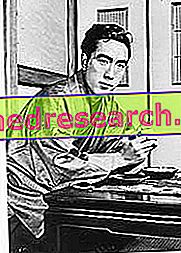Edited by Michela Verardo and Fabio Grossi
Knowledge of literature as a means to serve the Personal Trainer to enhance one's dialogue with customers and, of course, to enhance one's cultural and personal growth. Already Plato in his Republic (Politeia, circa 390 BC) argued that culture - poetry and music in particular - and physical activity were the most suitable tools for educating the body and soul of man.
Yukio Mishima (1925 - 1970), Hiraoka Kimitake, was a Japanese writer and playwright, probably the most significant of the last century; he is one of the few Japanese writers who met with immediate success abroad, while in his Japan he often met a bitter criticism, decidedly not very generous towards his works.

The obsession with absolute beauty and the cult of the body merged into the practice of martial arts, which became the central topic of various novels including "Il Padiglione d'Oro" and "Sole e Acciaio", two real masterpieces.
Driven by intense passions and crushed by the contrast between Western innovation and Japanese tradition, he became a supporter of extreme ideologies. In 1970 he wanted to shake off the heroic and nationalist ideals of the young Japanese and carried out a paramilitary demonstrative act at the head of a handful of his followers and disciples.
Repressed and restrained by the police at the Japanese Ministry of Defense in Tokyo, where it intended to denounce the corruption and moral degradation in which modern Japan had sunk, it succeeded in reading a proclamation before its initiative ended in the most blatant demonstration of the his own obedience to the samurai code: the ritual of seppuku, or ritual suicide.
The proclamation is reported in full in the last pages of one of his works, or "Spiritual lessons for young samurai" .
Spiritual lessons for young samurai.
In this text Mishima explains how the body was, in the beginning for the Japanese, a concept of secondary importance. In fact, there were neither Apolli nor Veneri in Japan. In ancient Greece, on the contrary, the body was considered an essentially beautiful reality and to increase its charm meant to evolve humanly and spiritually. The Greek philosopher Plato affirmed that at first it is physical beauty that attracts and seduces us, but then through it we succeed in distinguishing the much more noble fascination of the Idea : the human body, therefore, as the metaphor of something that it transcends the physical, which goes beyond mere exteriority.
In Japan, on the other hand, martial arts enthusiasts considered the exercise of these disciplines absolutely foreign to the embellishment and artifice of the body, as a form of triumph of spiritual and moral values. A vision of the body - this - which has changed completely since the last World War, due to the influence of the American conception that, while not impersonating that revival of the spirit of ancient Greece, will show itself over time as a society substantially materialist that gives the utmost importance to image and physical appearance. According to Mishima, the more the power of television is strengthened, the more human images will be transmitted and absorbed instantaneously and even more the value of a subject will be established exclusively by its own exteriority; in the end, all societies will end up showing the value of a human being by its appearance. And goodbye Plato, alas ...!
In Japan Buddhism has always repudiated the empirical world, debasing the body and failing to provide for the worship of the body in any way. For the Japanese, in practice, the beauty was delineated by the features of a face, by a particular state of mind, by the elegance of the clothes ... A spiritual beauty, to make it short. The male body, a fortiori, was judged as a reality to be concealed, to be "bandaged" with the spirit. To make his authority public, the man needed to wear clothes that revealed his dignity.
The female body (at least in part) was the object of praise: initially the healthy and sensual beauty of prosperous women, of fresh and robust peasants, predominated and then passed to a conception of a more delicate and refined female body.
Throughout Asia until modern times, for a mentality extended even to the regions of the vast and vast former Soviet Union, men with powerful muscles were considered laborers, modest workers; the so-called gentlemen were invariably thin individuals with atrophic muscles . To affirm the virile beauty of the naked body would have required vigorous physical exercise, but every effort of the body was prevented from the nobles and individuals belonging to the upper classes.
In the eighteenth century in France, when culture reaches a very high degree of development, the artificiality of female beauty is admired, characterized by overflowing robes and very narrow busts, quite bizarre when compared to the naturalness of a naked body.
Yukio Mishima is keen to point out that whoever is provided with a pleasing physicist is not necessarily endowed with spiritual values, and cites in this regard the version of a Greek maxim (of which we know the Latin version of Juvenal, or mens sana in corpore sana ) which he considers to be inaccurate: "A healthy mind dwells in a healthy body" . According to the writer it should be conceived as follows: "May a healthy mind dwell in a healthy body", proving that, from the apogee of Greek civilization to the present day, the incompatibility between body and spirit has never ceased to afflict the human beings.
And it will never cease, presumably ...
Yukio Mishima, "Spiritual Lessons for Young Samurai, and Other Writings ", Universale Economica Feltrinelli, Milan 1990.



